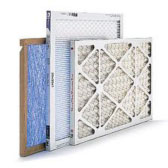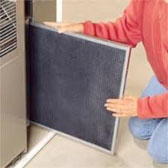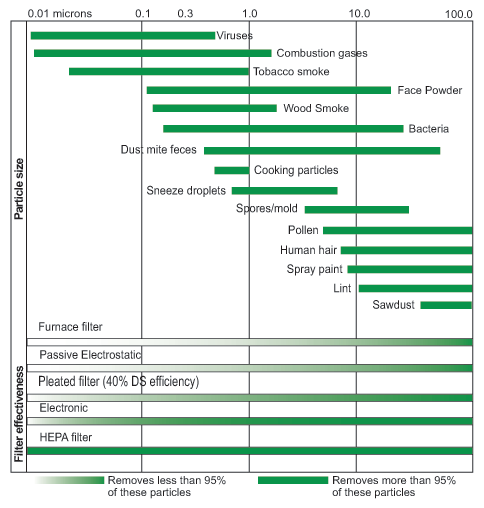Better Filtration Will RAISE Your Energy Bills……
 In a nutshell an effective way to reduce the particles moving through your system is to put in a tighter woven filter. The challenge is the tighter the furnace filter the worse your airflow. So often homeowners experiencing more dust than they would like, or people with allergies run off to the local lumber yard to buy a better filter. They look at the hundreds of choices and pick the $20 dollar Allergy Free Super Duper Deluxe Filter that blocks 99% of “something”. This creates a huge problem for your heating and cooling system. These high end filters significantly reduce the airflow of the system at the same time lowering the efficiency.
In a nutshell an effective way to reduce the particles moving through your system is to put in a tighter woven filter. The challenge is the tighter the furnace filter the worse your airflow. So often homeowners experiencing more dust than they would like, or people with allergies run off to the local lumber yard to buy a better filter. They look at the hundreds of choices and pick the $20 dollar Allergy Free Super Duper Deluxe Filter that blocks 99% of “something”. This creates a huge problem for your heating and cooling system. These high end filters significantly reduce the airflow of the system at the same time lowering the efficiency.
So How Do You Pick a Filter…..
Filtration vs. Air Cleaning
In order to understand the differences between filters you must first know what we are trying to collect. Once you know that you can get an understanding of where filters stop and air cleaners begin.
Filtration History
In 1935 the first forced air heating system was pioneered and introduced to the market. This is a very different way of heating a home compared to boilers, gravity systems, wood and coal burning stoves that do not use filtration. Since they are using a blower wheel or fan to force air through the system over burners to supply heated air to your house, filters emerged to protect the furnace components from damaged caused by the dirt, dust and other particles that pass through the furnace from this process. In 1952 these product lines were expanded to include central air conditioning and filtration was required year round while we started spending more time in our indoor air environment.
The energy crisis of 1973 started a national energy conservation effort that included tightening up our homes with better insulation, double and triple thermo pane windows, steel insulated doors, better siding and caulking, all to keep the heat inside during the winter and cool inside during the summer. Building materials also changed to include press wood and particle board which contain glue and adhesives that off-gas into the breathing space of your home and get circulated throughout the home by your forced air furnace.
People started spending much more time indoors as homes became tighter and central forced air heating and cooling systems became more prevalent. Indoor chemical use from chemical sprays, insecticides, carpets, paints, stains, air fresheners, candles, building materials, press wood in furniture, and other sources are on the rise and are trapped in our tight homes causing asthma, allergies and other ailments to be aggravated and increase. The accumulation of dirt and dust in the home and ducts are also significant contributors to the rise in asthma attacks and allergy symptoms.
Your forced air heating and cooling system circulates about 1.2 million cubic feet of air per day throughout your home that is filled with the three hazard levels and proper filtration or an air cleaner can significantly reduce the particle levels in the air you breathe.
Particles are measured in microns. One micron equals 1/25,400 of an inch. A grain of salt is about 70 microns in size and 98% of airborne particles measure below one micron in size. So, what’s the big deal? Well, even the best filters can only collect down to 1 micron in size. If they made the pores any smaller in the filter it would block too much air flow coming through your heating and cooling system. This would starve the system of air causing it to run harder and premature breakdowns.
The Purpose of Furnace Filters
 The purpose of an air filter is fairly simple: to block dirt, dust and other particles from getting into your furnace. When air enters your furnace to be heated or cooled it is distributed throughout your home and it brings all kinds of airborne particles along with it. If you didn’t have an air filter, all of those particles would build up in your furnace and cause premature breakdowns and it to run inefficiently. Those same particles would also accumulate onto your furnace components causing them to work inefficiently and breakdown. These particles would also be redistributed into your home’s air, which leads to poor indoor air quality and can aggravate symptoms of allergies and asthma.
The purpose of an air filter is fairly simple: to block dirt, dust and other particles from getting into your furnace. When air enters your furnace to be heated or cooled it is distributed throughout your home and it brings all kinds of airborne particles along with it. If you didn’t have an air filter, all of those particles would build up in your furnace and cause premature breakdowns and it to run inefficiently. Those same particles would also accumulate onto your furnace components causing them to work inefficiently and breakdown. These particles would also be redistributed into your home’s air, which leads to poor indoor air quality and can aggravate symptoms of allergies and asthma.
Furnace Filters and Air Flow Performance
Although air filters are an essential part of your furnace, they can also hinder it from performing efficiently. That’s because filters don’t just block out large particles, they also get in the way of your furnace’s air flow. What you’re left with is a situation where the better a filter is at blocking particles, the worse it is for allowing efficient air flow, and vice versa. A cheap fiberglass filter, for example, is great for air flow but bad for particle control. A pleated filter, on the other hand, is better at blocking particles but worse for air flow.
Filter manufacturers try to meet somewhere in the middle. You want to find a filter that will keep your unit running efficiently while also keeping your air clean and your family healthy. This is where an air cleaner comes into play.
Air Cleaners, Air Flow and Particle Control
Another option that homeowners have for particle control is an air cleaner. Air cleaners use a technology that makes them great at removing particles from the air while also letting air flow much more freely than it does with a pleated filter.
Keep in mind that even the best filters can only trap particles down to the one micron size and that’s only 2% of the particles that air in the air you breathe. 98% are below one micron in size and take a different technology than a filter to collect.
The VitalAir Solutions’ Micro Particle Shield Air Cleaner and Ultra HEPA Shield Bypass Filter System both control these submicron particles in the high 90% level while allowing for great air flow through your heating and cooling system.
